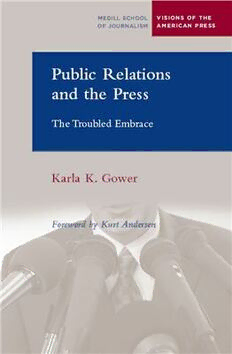
Public Relations and the Press: The Troubled Embrace PDF
Preview Public Relations and the Press: The Troubled Embrace
PUBLIC RELATIONS AND THE PRESS Medill School of Journalism VISIONS of the AMERICAN PRESS General Editor David Abrahamson Other titles in this series Herbert J.Gans Deciding What’s News:A Study ofCBS Evening News, NBCNightly News, Newsweek, andTime Maurine H.Beasley First Ladies and the Press:The Unfinished Partnership of the Media Age Patricia Bradley Women and the Press:The Struggle for Equality David A.Copeland The Idea of a Free Press:The Enlightenment and Its Unruly Legacy Michael Sweeney The Military and the Press:An Uneasy Truce Patrick S.Washburn The African American Newspaper:Voice of Freedom David R.Spencer The Yellow Journalism:The Press and America’s Emergence as World Power Tom Goldstein Journalism and Truth:Strange Bedfellows PUBLIC RELATIONS AND THE PRESS THE TROUBLED EMBRACE Karla K. Gower Foreword by Kurt Andersen MEDILL SCHOOL OF JOURNALISM Northwestern University Press Evanston, Illinois Northwestern University Press www.nupress.northwestern.edu Copyright © 2007 by Karla K. Gower Published 2007 by Northwestern University Press. All rights reserved. Printed in the United States of America 10 9 8 7 6 5 4 3 2 1 ISBN 978-0-8101-2434-9 Library of Congress Cataloging-in-Publication Data Gower, Karla K. Public relations and the press : the troubled embrace / Karla K. Gower ; foreword by Kurt Andersen. p. cm. — (Visions of the American press) Includes bibliographical references and index. ISBN-13: 978-0-8101-2434-9 (pbk. : alk. paper) ISBN-10: 0-8101-2434-3 (pbk. : alk. paper) 1. Journalism and public relations—United States. 2. Public relations—United States—History—20th century. 3. Journalism— Objectivity—United States. 4. Mass media—Objectivity—United States. I. Title. II. Series. HD59.6.U6G68 2007 659.20973—dc22 2007007892 The paper used in this publication meets the minimum requirements of the American National Standard for Information Sciences—Permanence of Paper for Printed Library Materials, ansi z39.48-1992. In loving memory of my parents CONTENTS ; Foreword by Kurt Andersen ix Preface xv One Introduction 1 Two The Rise of the Professional Source 13 Three Managing Social Change 41 Four Power to the People 67 Five Investigating Power 95 Six Blaming the Messenger 121 Seven Controlling the Message 147 Eight The Power Shift 173 Nine Conclusion 209 Notes 223 Bibliography 261 Index 285 FOREWORD ; Kurt Andersen In New York a century ago, as Professor Karla Gower so ably tells us, a twenty-seven-year-old man named Ivy Lee established Parker and Lee, the first firm devoted exclusively to managing spin, and thereby became a founder of the new business of public relations. The term public relations(PR)hadn’t been coined in 1904, but press agents were already familiar metropolitan figures—and automatically suspect, as they have remained. The muckraking New York reporter and photographer Jacob Riis, in an 1899 issue of the Atlantic Monthly,acidly referred to an employee of the cor- rupt local political machine as “Tammany’s press agent.” Indeed, press agentry and ad hoc public relations—the shaping of newspaper and magazine coverage to benefit particular private interests—had been powerfully, increasingly in evidence for most of the nineteenth century. The mass media and mass merchandis- ing were born in the 1830s and 1840s as cities boomed and high- speed printing presses made newspapers and magazines cheap and plentiful. And peddlers of every sort saw the burgeoning press as a prime new promotional venue. They could buy advertisements, but even better, they could wheedle and pressure writers and ed- itors to promote their wares for free—clothes, furniture, gadgets, plays, books, ideas, politicians, whatever. The embrace was troubling to some of those writers and edi- tors from the get-go. “It is a pity,” wrote one in theNew England Magazine in 1835, “that some efficient method could not be ix
